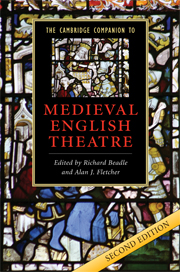Book contents
- Frontmatter
- 1 An introduction to medieval English theatre
- 2 The theatricality of medieval English plays
- 3 The cultural work of early drama
- 4 The York Corpus Christi Play
- 5 The Chester cycle
- 6 The Towneley pageants
- 7 The N-Town plays
- 8 The non-cycle plays and the East Anglian tradition
- 9 Morality plays
- 10 Saints and miracles
- 11 Modern productions of medieval English drama
- 12 A guide to criticism of medieval English theatre
- Select bibliography
- Author index to the bibliography
- General index
2 - The theatricality of medieval English plays
Published online by Cambridge University Press: 28 November 2011
- Frontmatter
- 1 An introduction to medieval English theatre
- 2 The theatricality of medieval English plays
- 3 The cultural work of early drama
- 4 The York Corpus Christi Play
- 5 The Chester cycle
- 6 The Towneley pageants
- 7 The N-Town plays
- 8 The non-cycle plays and the East Anglian tradition
- 9 Morality plays
- 10 Saints and miracles
- 11 Modern productions of medieval English drama
- 12 A guide to criticism of medieval English theatre
- Select bibliography
- Author index to the bibliography
- General index
Summary
Medieval plays were not written for the theatre. They were put on in city streets, in churches, on playing fields, in college halls and in private houses, and they exploited each of these venues in its own distinctive way. The shape and acoustics of the venue, the skills of the actors, the nature of the audience and of the occasion, all presented certain constraints and certain opportunities. Add to this a variety of types of subject matter, and we have not one but a whole range of theatricalities.
Plays are for performing, and one recent branch of medieval theatre research has specialised in the informed ‘recreation’ of medieval performance conditions. This has been an eye-opening and salutary exercise. Because medieval theatre is so different from modern commercial theatre both in setting and intention, we modern investigators have had to break down our prejudices about the practical limits of staging and acting style. We have discovered, among other things, that actors can perform on a stage eight feet by ten feet; that twenty-foot-high pageant wagons are not necessarily doomed to overbalance; that long rhetorical speeches are not by definition ‘boring’; that spectacle can speak more strongly than words; that it is possible to look the audience full in the face. Above all we have learnt to trust the plays themselves: that if we take them seriously as theatre, they will work. Medieval theatre has emerged not as childlike or primitive, but as different, and often highly sophisticated.
- Type
- Chapter
- Information
- The Cambridge Companion to Medieval English Theatre , pp. 26 - 74Publisher: Cambridge University PressPrint publication year: 2008
- 1
- Cited by

